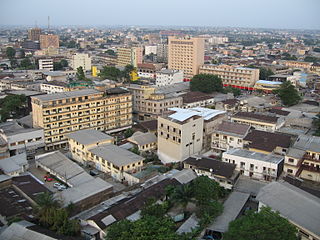Duala is a dialect cluster spoken by the Duala and Mungo peoples of Cameroon. Douala belongs to the Bantu language family, in a subgroup called Sawabantu. It is a tonal language with subject–verb–object word order. Maho (2009) treats Douala as a cluster of five languages: Douala proper, Bodiman, Oli, Pongo and Mongo. He also notes a Douala-based pidgin named Jo.

Schutztruppe was the official name of the colonial troops in the African territories of the German colonial empire from the late 19th century to 1918. Similar to other colonial armies, the Schutztruppen consisted of volunteer European commissioned and non-commissioned officers, medical and veterinary officers. Most enlisted ranks were recruited from indigenous communities within the German colonies or from elsewhere in Africa.

Jesko Albert Eugen von Puttkamer was a German diplomat, colonial administrator, and military officer who served as colonial governor of German Kamerun from 1895 to 1907.

Hans Dominik was a German colonial officer of the Schutztruppe. He was the long-time commander of the Jaunde military station in Kamerun.

Douala is the largest city in Cameroon and its economic capital. It is also the capital of Cameroon's Littoral Region. It was home to Central Africa's largest port, now being replaced by Kribi port. It has the country’s major international airport, Douala International Airport (DLA). It is the commercial and economic capital of Cameroon and the entire CEMAC region comprising Gabon, Congo, Chad, Equatorial Guinea, Central African Republic and Cameroon. Consequently, it handles most of the country's major exports, such as oil, cocoa and coffee, timber, metals and fruits. As of 2023, the city and its surrounding area had an estimated population of 2,768,400. The city sits on the estuary of Wouri River and its climate is tropical.

Ndumbé Lobé Bell or King Bell was a leader of the Duala people in what is now the southern part of Cameroon during the period when the Germans established their colony of Kamerun. He was an astute politician and a highly successful businessman.

Julius Freiherr von Soden was a German colonial administrator and politician. He was the Governor of the colonies of Kamerun and German East Africa, and later became Chef de Cabinet and Foreign Minister of the King of Württemberg.

Jantzen & Thormählen was a German firm based in Hamburg that was established to exploit the resources of Cameroon. The firm's commercial and political influence was a major factor in the establishment of the colony of Kamerun in 1884.

The Kamerun campaign took place in the German colony of Kamerun in the African theatre of the First World War when the British, French and Belgians invaded the German colony from August 1914 to March 1916. Most of the campaign took place in Kamerun but skirmishes also broke out in British Nigeria. By the Spring of 1916, following Allied victories, the majority of German troops and the civil administration fled to the neighbouring neutral colony of Spanish Guinea. The campaign ended in a defeat for Germany and the partition of its former colony between France and Britain.

The villa Mandessi Bell situated at Douala is a building constructed between 1904 and 1909 by David Mandessi-Bell a rich farmer and commissioner of the king Rudolf Manga Bell. This building is and architecture from the colonial period. It is a representation and legacy of the German occupation in Cameroon.

The Palace of King Bell situated in Douala is a building constructed in 1905 by the Germans for King Auguste Manga Ndumbe. The building is also known as La Pagode; this name comes from the French writer Louis-Ferdinand Céline, who remained in Douala in 1916–17, who calls it such in his famous novel Voyage au bout de la nuit.

The former Palace of Justice of Douala situated in Douala is a building originally constructed between 1930-31 under the French Mandate.

The former General Hospital situated in Douala is a building constructed in 1896 by the Germans and designed by the architect Henri Drees.

The Bonakouamouang Chimney – situated in Douala, Cameroon in the district of Akwa neighborhood of Bessegue – is a relict of the waterworks built by the Germans at the beginning of the 19th century. The waterworks was part of the first phase of industrial investments aimed at the urbanisation of Kamerunstadt (Douala).

The former police station situated in Douala is a building constructed at the beginning of the 20th century by the Germans to serve as the first police station under the German mandate.

The Cathedral of Saints Peter and Paul - situated in Douala, Cameroon - is the cathedral of the Roman Catholic Archdiocese of Douala and dedicated to St Peter and St Paul.

The Chamber of Commerce in Douala, Cameroon is a building constructed between 1927 and 1928 under the French mandate, under the umbrella of the League of Nations. This building is in a late Art Nouveau architectural style.
The following is a timeline of the history of the city of Douala, Cameroon.

Joseph-Francis Sumégné was born on 30 July 1951 in Bamenjou, Cameroon. Painter and sculptor since 1976, he is a self-taught artist. He lives and works in Yaoundé (Cameroon).

Ernst Klaus Iwan Christian Friedrich Alfred von Raben was a German Major who had served as a commander of the Schutztruppe before surrendering at the Siege of Mora.



















